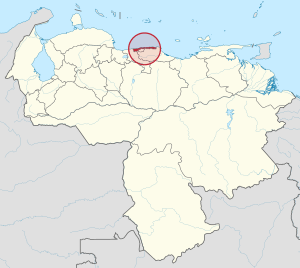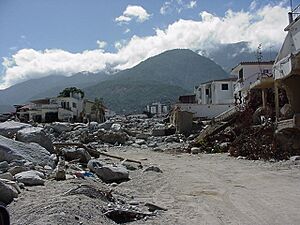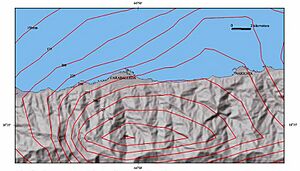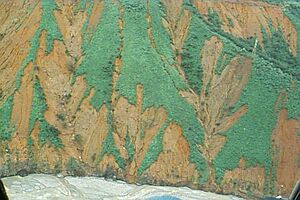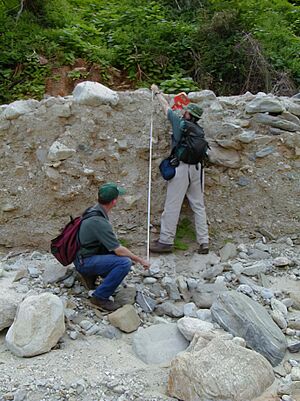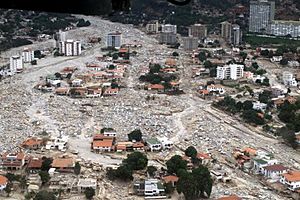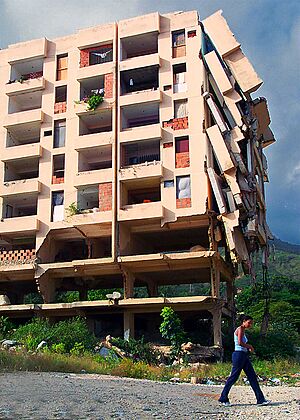Vargas tragedy facts for kids
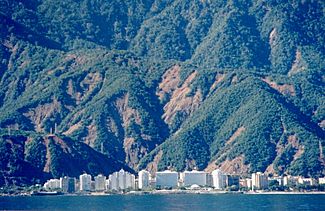
A part of Vargas state after the 1999 mudslides
|
|
| Date | 5–21 December 1999 |
|---|---|
| Location | Vargas State, Venezuela |
| Coordinates | 10°36′18.67″N 66°50′58.21″W / 10.6051861°N 66.8495028°W |
| Deaths | 10,000–30,000 |
|
|
|
The Vargas tragedy was a terrible natural disaster that happened in Vargas State, Venezuela. It started on December 15, 1999, and lasted for about 10 days. Very heavy rains caused huge flash floods and mudslides, also known as debris flows. These events killed tens of thousands of people and destroyed thousands of homes. The entire area's roads, power, and water systems completely broke down.
Rescue workers said that the neighborhood of Los Corales was buried under 3 meters (about 10 feet) of mud. Many homes were simply washed away into the ocean. Whole towns, like Cerro Grande and Carmen de Uria, disappeared completely. It's thought that as much as 10% of the people living in Vargas State died during this disaster.
Contents
Why Did It Happen?
The coastal area of Vargas State has often had mudslides and floods. Rocks and soil left behind by old floods show that similar disasters have happened regularly for thousands of years. Since the 1600s, there have been at least two big mudslides or floods each century in Vargas. Some recorded events happened in 1798, 1912, 1914, 1938, 1944, 1948, and 1951. In 1798, flash floods badly damaged 219 homes.
Before 1999, the biggest flood was in 1951, but it didn't cause as much damage. Geologists compared the 1951 event to the 1999 one. The 1951 flood had less rain, fewer landslides, and less new mud. The storm in December 1999 was much stronger. It dropped 911 millimeters (about 36 inches) of rain in just a few days. This caused the ground to become very unstable, leading to huge mudslides. Also, many more people lived in Vargas State in 1999 than in 1951. This meant more people were in danger when the disaster hit.
Many People Lived There
The flat areas along the mountainous coast of Venezuela are formed by mud and rocks carried by floods and mudslides. These flat areas are the only wide, flat spaces available. Because of this, many towns and cities have been built on them. When many people live in these areas, the risk of harm from flash floods and mudslides becomes much higher.
In 1999, hundreds of thousands of people lived in this narrow coastal strip in Vargas State. Many of these people lived on top of these flat areas, called alluvial fans. These fans were formed by mudslides coming from the 2,000-meter (about 6,500-foot) peaks to the south.
Heavy Rains
December 1999 was unusually wet for the coast of Venezuela. The first storm that month happened on December 2-3 and brought 200 millimeters (about 8 inches) of rain.
Two weeks later, from December 14 to 16, an incredible 911 millimeters (about 36 inches) of rain fell in just 52 hours. This is about how much rain the region usually gets in a whole year! This rain was measured at Simón Bolívar International Airport in Maiquetia, Venezuela. On December 16, 72 millimeters (about 3 inches) of rain fell in just one hour. The amount of rain on December 15 and 16 was more than what is expected in a 1,000-year period. Even with all this rain, the coast received less rain than some areas higher up in the mountains.
This sudden and intense storm was very unusual because it happened in December. The normal rainy season in coastal Venezuela is from May to October. These out-of-season rains happened when a cold air mass met moist air from the Pacific Ocean. This caused moderate to heavy rain starting in early December, leading up to the huge storm on December 14-16 that caused the deadly floods and mudslides.
The heaviest rains were in the middle and upper parts of the San Julián basin. This basin feeds water and mud onto the Caraballeda fan. Heavy rains continued within 8 kilometers (about 5 miles) of the coast. The rain became less intense closer to Caracas and towards Maiquetía.
How the Land Was Formed
The land around Caracas is mostly made of metamorphic rocks. These are rocks that have changed due to heat and pressure. The way these rocks are layered can make landslides more likely. If the layers slope towards an open area, the ground can easily slide along these layers.
The flat areas (alluvial fans) that stretch into the sea were built by earlier floods and mudslides. The river channels in these areas are cut into older mud and flood material. Scientists from the US Geological Survey studied these old deposits. They found that these older layers were thicker than the ones from December 1999 and contained bigger rocks. This means that past mudslides were even larger and moved faster than those in 1999.
On the Caraballeda fan, the 1951 flood was much smaller than the 1999 event. Most of the Caraballeda fan is made of deposits that are similar in thickness and rock size to those from 1999.
The Disaster Unfolds
Very heavy rains fell along the north-central coast of Venezuela in December 1999. The most intense rain was from December 14 to 16. Around 8 PM on December 15, water rushed into river channels and flowed towards the sea. As it moved, it picked up and dropped mud and rocks. After this first wave of flooding, thousands of shallow landslides began. These landslides stripped soil and rock from the mountainsides. The water then turned these landslides into debris flows. These are like thick, fast-moving rivers of water, rocks, and mud.
The first people saw mudslides around 8:30 PM on December 15. The last ones were reported between 8 and 9 AM on December 16. Many areas had multiple mudslides. Some of these carried huge rocks and tree trunks onto the flat areas near the coast. From 7 to 9 AM on the 16th, and continuing into that afternoon, a new wave of floods happened. These floodwaters had less mud but were still powerful. They carved new channels into the ground and moved more material.
The mudslides moved very quickly and caused a lot of destruction. Based on the size of the rocks found and how high the flow was, geologists guess the mudslides moved between 3.3 and 14.5 meters per second (about 7 to 32 miles per hour). These fast, rocky flows caused much of the damage.
Besides the mudslides, flash floods with a lot of sediment were also very dangerous. Together, the flash floods and mudslides destroyed hundreds of houses, bridges, and other buildings. They carved new channels several meters deep into every flat area along the Vargas state coastline. They also covered these areas with thick layers of mud and rocks.
Caraballeda Fan: A Hard-Hit Area
The Caraballeda fan was one of the worst-hit communities. This was for two main reasons. First, Caraballeda was very built up, with many tall buildings and multi-story houses. Second, it is at the mouth of the Quebrada San Julián (Saint Julian Ravine). This river basin produced very large rocks and covered a huge area with mud. About one-third of the Caraballeda fan was covered by mudslides. The entire fan is actually built from past mudslide deposits.
The floods and mudslides of 1999 did not follow the eastern channel in Caraballeda. This channel was built after the 1952 floods to safely carry water to the sea. Instead, the mudslides were too big for the channel. They spilled over the banks wherever the channel turned. Once free, the mudslides quickly changed course and spread mud and rocks throughout the community. These overflowing flows destroyed two-story houses and the first two floors of apartment buildings. Farther down the fan, the mudslides flowed down streets. As they moved, they left thinner deposits, but they were often still over 1 meter (3 feet) thick. After several changes in course, the channel roughly followed the path it had before the 1951 flood.
Geologists from the USGS estimate that at least 1.8 million cubic meters (about 63.5 million cubic feet) of material was deposited. This is one of the largest mudslide deposits caused by rain ever recorded. The deposits extended the shoreline 40–60 meters (about 130-200 feet) into the sea. The deposits were 4–5 meters (up to 5.3 meters) thick near the center of the fan and about 0.5 meters thick near the old shoreline. The largest rocks were found closer to the mountains, as the slope of the land decreased towards the sea.
Damage Caused
The disaster caused an estimated $1.79 billion to $3.5 billion US dollars in damage. The number of deaths is thought to be between 10,000 and 30,000. It's hard to know the exact number because there wasn't good population data for the area, especially for small communities that were completely wiped out. Also, only about 1,000 bodies were found. The rest were either swept out to sea by the mud or buried in the landslides.
More than 8,000 homes and 700 apartment buildings were destroyed in Vargas. This left up to 75,000 people without a home. The mudslides changed more than 60 kilometers (about 37 miles) of the coastline in Vargas. Over 70% of the people living in Vargas State were affected by the disaster.
Basic services like water, electricity, phone lines, and transportation (roads and bridges) completely disappeared in some places. There was no food or water for months, so most people had to be moved out of the area. There was also looting, which forced the military to take control for more than a year.
See also
 In Spanish: Tragedia de Vargas para niños
In Spanish: Tragedia de Vargas para niños
- Armero tragedy – a similar mudslide disaster caused by a volcano in Colombia in 1985


